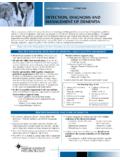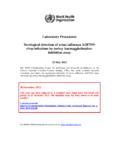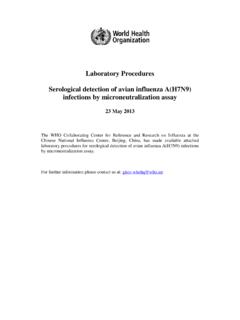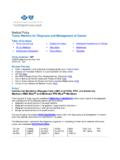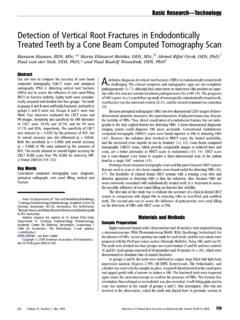Transcription of Diagnosis of Dementia In Individuals with Intellectual ...
1 PAGE 1 Diagnosis of DementiaIn Individuals withIntellectual DisabilityOCTOBER 1995 Report of the AAMR-IASSID Working Group for theEstablishment of Criteria for the Diagnosis of Dementia in Individuals with Intellectual DisabilityPAGE 2 For Additional Copies or Comments ContactAmerican Association on Mental RetardationATTN: Alzheimer Disease Workgroup444 North Capitol Street, 846 Washington, DC 20001-1512_ 1-202-387-1968 FAX 1-202-387-2193 Also available:Practice Guidelines for the Clinical Assessment and Care Management of Alzheimer and other Dementias among Adults with Mental RetardationSuggested CitationE. H. Aylward, D. B. Burt, Thorpe, F. Lai, & Dalton.
2 (1995). Diagnosisof Dementia in Individuals with Intellectual disability . Washington:American Association on Mental Retardation(Note: This report also submitted for publication; acceptance pending)Author's Affiliations:E. H. Aylward, (Department of Psychiatry, The Johns Hopkins University School of Medicine, Baltimore,MD, USA); D. B. Burt, (Center for Human Development Research, University of Texas at HoustonHealth Science Center, Houston, TX, USA); Thorpe, (University of Saskatoon, Saskatoon,Saskatchewan, Canada); F. Lai, (Eunice Kennedy Shriver Center, Mental Retardation Research Center,Waltham, MA, USA); Dalton, (New York State Institute for Basic Research in DevelopmentalDisabilities, Staten Island, NY, USA)Acknowledgments:The work on this report was supported in part by a conference support grant from the National Institutes ofAging and Child Health and Human Development (#I-R13-AG/HD 12353-01; : M.)
3 Janicki) as well as grantsfrom the National Institute for disability and Rehabilitation Research (#H133E1000893A; M. Janicki) andfrom the National Institute of Aging (ROI NS28115; : G. Pearlson). We are indebted to the participants of theInternational Colloquium on Alzheimer Disease and Mental Retardation (Minneapolis, Minn: July 28-29, 1994),participants at a focus/expert group meetings held in Manchester, England (October 25, 1994) and in NewYork, New York (January 20- 21, 1995), and numerous others for their comments, suggestions, andcontributions to this 3 Diagnosis of Dementia in Individuals withIntellectual DisabilityE. H. Aylward, , D. B. Burt, , Thorpe, Lai, Dalton, of the Working Group for the Establishment of Criteria for the Diagnosis of Dementia in Individuals with Intellectual Disability1 under the auspices of the International Association for the Scientific Study of Intellectual disability (IASSID)and the American Association on Mental Retardation (AAMR)Abstract: This is report proposes a set of standardized criteria for the Diagnosis ofdementia in Individuals with Intellectual disability (ID) and a standardized procedurefor determining whether or not criteria are met in individual cases.
4 It is the authors'intention that these criteria be appropriate for use by both clinicians and need for standardized criteria and diagnostic procedures was identified by agroup of clinicians and researchers attending the International Colloquium onAlzheimer Disease and Mental Retardation2, as one of the foremost impediments toprogress in the understanding and treatment of this condition. The diagnostic criteriaand procedures outlined in this report are endorsed by those who attended theInternational Colloquium. 1 For Working Group participants and affiliations, see page The International Colloquium on Alzheimer Disease and Mental Retardation was held in Minneapolis, Minnesota, on July 28-29, 1994, with support from the National Institute on Aging and the National Institute for disability and Rehabilitation Research ( : ) (1-3).
5 PAGE 4 INTRODUCTIONB ecause of medical advances and improved living circumstances, individualswith ID are living longer (4-5). As age isthe strongest risk factor for develop ingdementia, the likelihood that indi vidualswith ID may develop Dementia isincreasing. It is known, for example, thatall Individuals with Down syndrome (DS)develop the characteris ticneuropathological brain lesions ofAlzheimer disease (AD) ( , neuriticplaques, granulo-vacuolar changes,cerebral vascular amyloidosis, Hiranobodies and neurofibrillary tangles) by theage of 40 years (6), although many do notdemonstrate clinical features of is increasing interest in accuratedetection of Dementia in these individualsfor practical purposes, such as programplanning and clinical care.
6 There is alsogrowing awareness of the need foraccurate methods of differenti atingindividuals who have progressive,irreversible Dementia ( , AD) fromthose who have cognitive decline due totreatable in accurate Diagnosis is alsoincreasing within the research community, especially as research methodolo giesbecome available to answer ques tionsregarding factors associated withdementia, including genetic and neuroanatomical abnormalities. Unfortu nately,lack of standard diagnostic pro cedureshas limited meaningful commu nicationamong research laboratories.
7 Forexample, some published studiesinvolving Individuals with ID and Dementia do not report how a Diagnosis ofdementia was made. In other studies, allindividuals with DS over the age of 40have been assumed to be demented, evenwhen currently accepted standards ofpractice for the Diagnosis of AD ( ,medical workup, longitudinal confirmation of deterioration, exclusion of othercauses of impairment) have not who do specify themethod for Diagnosis have employeda variety of both published andunpublished criteria for diagnosingdementia ( , NINCDS- ADRDA criteria for Alzheimer Disease (7),CERAD (Consortium to Establish aRegistry for Alzheimer's Disease))
8 Criteria (8)), modified in a variety ofdifferent ways. This has led to largedifferences among research groupsregarding such basic findings asincidence and prevalence figures (seeZigman et al (9)). Until a standardizedset of criteria is accepted byresearchers in this field, we will beunable to determine whether the brainchanges of AD in Individuals with DSare even relevant to the Diagnosis ofdementia. Furthermore, we obviouslycannot expect to make progressregarding more complicated aspectsof Dementia in Individuals with IDwithout first establishing agreementon what constitutes Dementia in thispopulation.
9 Generally acceptedcriteria for the Diagnosis of dementiain Individuals with ID are alsoessential for therapeutic trials,evaluation of new diagnosticlaboratory tests, and studiesregarding the pathogenesis of current diagnostic systemsaddress both ID and Dementia , theydo not address the issue of diagnosisof Dementia in adults with ID. TheDiagnostic and Statistical Manual ofMental Disorders (DSM-IV) (10)mentions mental retardation in regardto "differential Diagnosis " of Dementia ,stating that "Mental retardation ischaracterized by significantlysubaverage current generalintellectual functioning, withPAGE 5concurrent impairments in adaptivefunctioning and with an onset before age18 years.
10 Mental retardation is notnecessarily associated with memoryimpairment. In contrast, the age of onsetof Dementia is usually late in life" (pp. 138-139). DSM-IV provides further discussionregarding the Diagnosis of Dementia inindividuals with ID under the age of 18,but does not provide any informationregarding a dual Diagnosis of ID anddementia in older Individuals . TheInternational Classification of Diseases(ICD-10) (11) does not mention intellectualdisability in regard to differentialdiagnosis of with both ICD-10 and DSM-IVdefinitions of Dementia , the proposeddiagnostic criteria for Dementia inindividuals with ID requiredocumentation of cognitive decline thatcauses impairment in social oroccupational functioning.


